英语人教版七年级上册语法
- 格式:ppt
- 大小:212.00 KB
- 文档页数:16
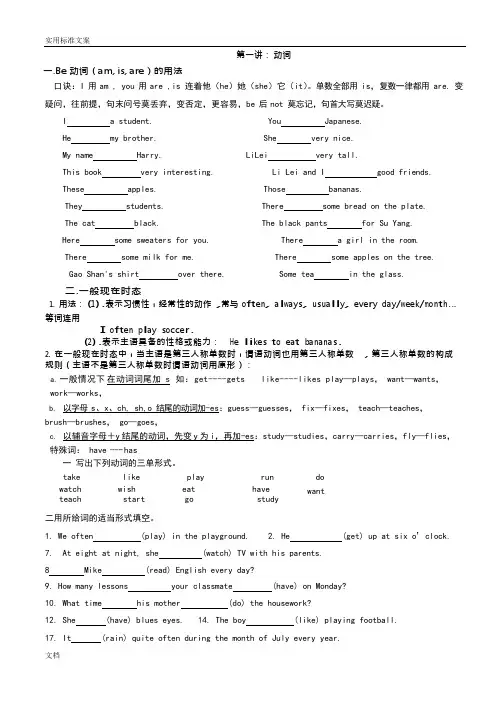
第一讲:动词一.Be 动词(am, is, are)的用法口诀:I 用 am , you 用 are ,is 连着他(he)她(she)它(it)。
单数全部用 is,复数一律都用 are. 变疑问,往前提,句末问号莫丢弃,变否定,更容易,be 后 not 莫忘记,句首大写莫迟疑。
I a student. You Japanese.He my brother. She very nice.My name Harry. LiLei very tall.This book very interesting. Li Lei and I good friends.These apples. Those bananas.They students. There some bread on the plate.The cat black. The black pants for Su Yang.Here some sweaters for you. There a girl in the room.There some milk for me. There some apples on the tree.Gao Shan's shirt over there. Some tea in the glass.二.一般现在时态1.用法:(1).表示习惯性,经常性的动作,常与o f t e n,a l w a y s,u s u a ll y,e v e r y d a y/w ee k/m o n t h…等词连用I o f t e n p l a y s o cc e r.(2).表示主语具备的性格或能力:H e li k e s t o e a t b a n a n a s.2.在一般现在时态中,当主语是第三人称单数时,谓语动词也用第三人称单数, 第三人称单数的构成规则(主语不是第三人称单数时谓语动词用原形):a.一般情况下在动词词尾加 s 如:get----gets like----likes play—plays, want—wants,work—works,b.以字母 s、x、ch, sh,o 结尾的动词加-es:guess—guesses, fix—fixes, teach—teaches,brush—brushes, go—goes,c.以辅音字母+y 结尾的动词,先变y 为i,再加-es:study—studies,carry—carries,fly—flies,特殊词: have --- has一写出下列动词的三单形式。
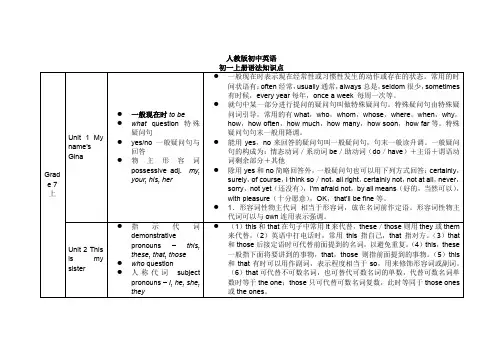

七年级上册英语语法1.介词:in, on, under, behind, near, at, of1). in表示"在……中", "在……内"。
例如: in our class 在我们班上 in my bag 在我的书包里 in the desk 在桌子里 in the classroom 在教室里2). on blackboard 在黑板上3). under表示"在……下"。
例如: under the tree 在树下 under the chair 在椅子下 under the bed 在床上4). behind表示"在……后面"。
例如: behind the door 在门后 behind the tree 在树后5). near表示"在……附近"。
例如: near the teacher's desk 在讲桌附近 near the bed 在床附近6). at表示"在……处"。
例如: at school 在学校 at home 在家 at the door 在门口7). of 表示"……的"。
例如: a picture of our classroom 我们教室的一幅画 a map of China 一张中国地图2.冠词 a / an / the: 冠词一般位于所限定的名词前,用来署名名词所指的人或事物。
冠词有不定冠词和定冠词两种。
1)不定冠词有两个形式,即a和an。
a用在以辅音音素开头的词前,如a book; an用在以元音音素开头的字母前,如an apple. a或an与可数名词单数连用,泛指某类人或某物中的一个。
This is a cat. 这是一只猫。
It's an English book. 这是一本英语书。
His father is a worker. 他的爸爸是个工人。
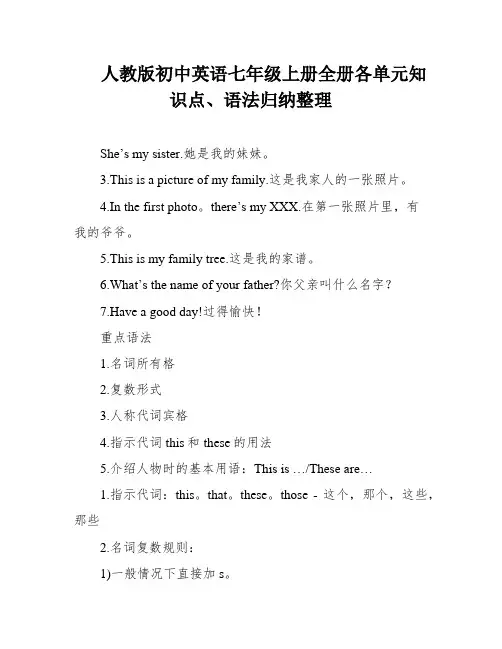
人教版初中英语七年级上册全册各单元知识点、语法归纳整理She’s my sister.她是我的妹妹。
3.This is a picture of my family.这是我家人的一张照片。
4.In the first photo。
there’s my XXX.在第一张照片里,有我的爷爷。
5.This is my family tree.这是我的家谱。
6.What’s the name of your father?你父亲叫什么名字?7.Have a good day!过得愉快!重点语法1.名词所有格2.复数形式3.人称代词宾格4.指示代词this和these的用法5.介绍人物时的基本用语:This is …/These are…1.指示代词:this。
that。
these。
those - 这个,那个,这些,那些2.名词复数规则:1)一般情况下直接加s。
2)以s,x,sh,ch结尾的加es。
3)以辅音字母加y结尾的将y变i再加es。
4)以o结尾的加s或es。
(有生命+es物生命加s)5)以f/fe结尾的名词,先将f/fv变成v再加es。
3.人称代词:I。
he。
she。
it和they - 我,他,她,它,他们/她们/它们4.重点短语:Is this/that your。
- 这/那是你的……吗?Yes。
it is。
/ No。
it isn't。
- 是的,是它。
/ 不,不是。
XXX。
- 这些/那些是我的……Here are。
- 这里有……This/That is my。
- 这/那是我的……Have a good day。
- 祝你玩得愉快!Excuse me for interrupting。
but could I ask you a n?Thank you very much.Could you please speak in English?Do you enjoy playing computer games?Have you checked in the lost and found case to see if your item is there?Please call 685-6034 to reach me.I lost my school ID card and need to find it.I need a set of pencils for my art class.Key XXX structures:Is that your school bag?No。
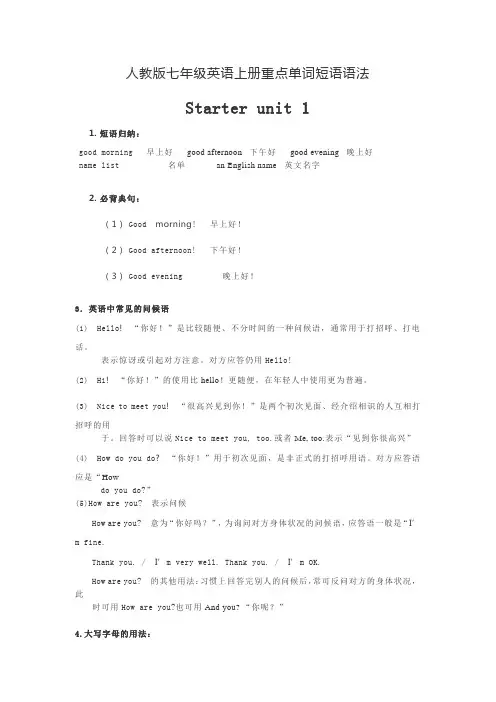
人教版七年级英语上册重点单词短语语法Starter unit 11. 短语归纳:good morning 早上好good afternoon 下午好good evening 晚上好name list 名单an English name 英文名字2. 必背典句:(1)Good morning! 早上好!(2)Good afternoon! 下午好!(3)Good evening 晚上好!3.英语中常见的问候语(1) Hello!“你好!”是比较随便、不分时间的一种问候语,通常用于打招呼、打电话。
表示惊讶或引起对方注意。
对方应答仍用Hello!(2) Hi!“你好!”的使用比hello!更随便,在年轻人中使用更为普遍。
(3) Nice to meet you!“很高兴见到你!”是两个初次见面、经介绍相识的人互相打招呼的用于。
回答时可以说Nice to meet you, too.或者Me, too.表示“见到你很高兴”(4) How do you do?“你好!”用于初次见面,是非正式的打招呼用语。
对方应答语应是“Howdo you do?”(5)How are you? 表示问候How are you? 意为“你好吗?”,为询问对方身体状况的问候语,应答语一般是“I’m fine.Thank you. / I’m very well. Thank you. / I’m OK.How are you? 的其他用法:习惯上回答完别人的问候后,常可反问对方的身体状况,此时可用How are you?也可用And you? “你呢?”4.大写字母的用法:(1) 在英语中,句子的第一个单词的第一个字母都应大写。
Sit down, please. 请坐。
(2)字母I作人称代词时,意为“我”,在句中任何位置都必须大写。
日常用语“OK”在句中任何位置都大写。
I’m a student. 我是一名学生。
Is everything OK? 一切都好吗?(3)人名、地名、国名、某国人或某种语言等专有名词的第一个字母都必须大写。

人教版七年级英语语法点一、名词。
1. 名词的复数形式。
- 一般情况在词尾加 -s,如book - books,pen - pens。
- 以s, x, sh, ch结尾的名词,加 -es,如bus - buses,box - boxes,brush - brushes,watch - watches。
- 以辅音字母 + y结尾的名词,变y为i,再加 -es,如baby - babies,city - cities。
但以元音字母 + y结尾的名词,直接加 -s,如boy - boys,day - days。
- 以f或fe结尾的名词,多数变f或fe为v,再加 -es,如knife - knives,leaf - leaves,但也有一些直接加 -s,如roof - roofs。
- 不规则复数形式,如man - men,woman - women,child - children,foot - feet,tooth - teeth,mouse - mice等。
2. 名词所有格。
- 有生命的名词所有格,一般在名词后加's,如Tom's book(汤姆的书)。
如果名词是复数且以s结尾,只加',如the students' classroom(学生们的教室)。
- 表示无生命的名词所有关系,常用“of + 名词”结构,如the window of the room(房间的窗户)。
二、代词。
1. 人称代词。
- 主格:I(我),you(你/你们),he(他),she(她),it(它),we(我们),they(他们/她们/它们)。
主格在句中作主语,如I like English.(我喜欢英语。
)- 宾格:me(我),you(你/你们),him(他),her(她),it(它),us (我们),them(他们/她们/它们)。
宾格在句中作宾语,如He helps me.(他帮助我。
)2. 物主代词。
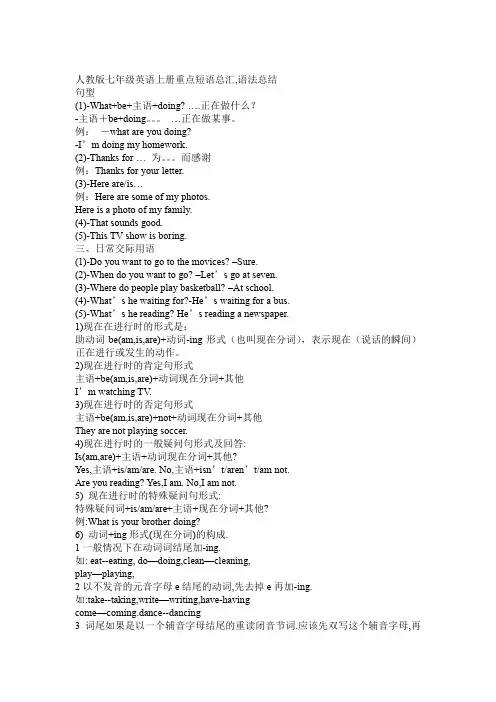
人教版七年级英语上册重点短语总汇,语法总结句型(1)-What+be+主语+doing? ….正在做什么?-主语+be+doing。
…正在做某事。
例:-what are you doing?-I’m doing my homework.(2)-Thanks for … 为。
而感谢例:Thanks for your letter.(3)-Here are/is…例:Here are some of my photos.Here is a photo of my family.(4)-That sounds good.(5)-This TV show is boring.三、日常交际用语(1)-Do you want to go to the movices? –Sure.(2)-When do you want to go? –Let’s go at seven.(3)-Where do people play basketball? –At school.(4)-What’s he waiting for?-He’s waiting for a bus.(5)-What’s he reading? He’s reading a newspaper.1)现在在进行时的形式是:助动词be(am,is,are)+动词-ing形式(也叫现在分词),表示现在(说话的瞬间)正在进行或发生的动作。
2)现在进行时的肯定句形式主语+be(am,is,are)+动词现在分词+其他I’m watching TV.3)现在进行时的否定句形式主语+be(am,is,are)+not+动词现在分词+其他They are not playing soccer.4)现在进行时的一般疑问句形式及回答:Is(am,are)+主语+动词现在分词+其他?Yes,主语+is/am/are. No,主语+isn’t/aren’t/am not.Are you reading? Yes,I am. No,I am not.5) 现在进行时的特殊疑问句形式:特殊疑问词+is/am/are+主语+现在分词+其他?例:What is your brother doing?6) 动词+ing形式(现在分词)的构成.1一般情况下在动词词结尾加-ing.如: eat--eating, do—doing,clean—cleaning,play—playing,2以不发音的元音字母e结尾的动词,先去掉e再加-ing.如:take--taking,write—writing,have-havingcome—coming.dance--dancing3词尾如果是以一个辅音字母结尾的重读闭音节词.应该先双写这个辅音字母,再加-ing.如:run—runing,sit—sitting ,swim—swimming.Shop—shopping.put—putting,sit—sittingUnit 6 It’s raning!一、词组Around The World 世界各地On vacation 度假Take photos 拍照On the beach 在海边a group of people 一群人play beach volleyball 打沙滩排球be surprised 惊讶的be surprised at sth./sb.对某人或某人感到惊讶be relaxed 放松have a good time 玩得很痛快in different kind of weather 在不同的天气里Thank sb for(doing)sth由于(做)某事而感谢某人How’s it going? 近况如何Some…others…一些…另一些…Look like..看起来像。
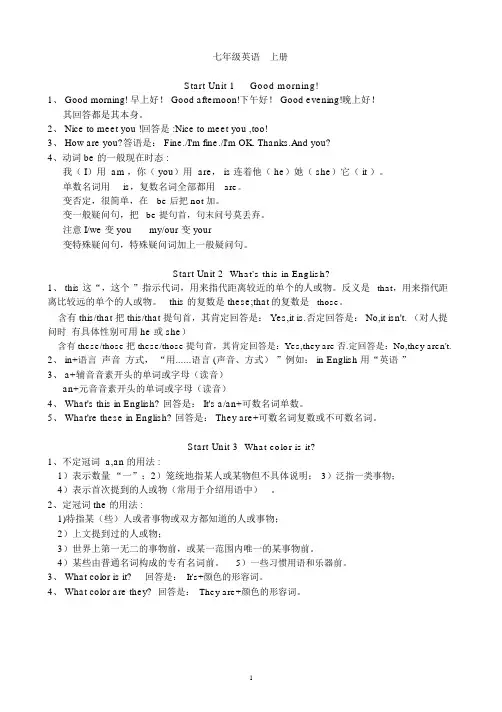
七年级英语上册Start Unit 1Good morning!1、 Good morning! 早上好! Good afternoon!下午好! Good evening!晚上好!其回答都是其本身。
2、 Nice to meet you !回答是 :Nice to meet you ,too!3、 How are you?答语是: Fine./I'm fine./I'm OK. Thanks.And you?4、动词 be 的一般现在时态 :我( I)用 am ,你( you)用 are, is 连着他( he)她( she)它( it )。
单数名词用is,复数名词全部都用are。
变否定,很简单,在be 后把 not 加。
变一般疑问句,把be 提句首,句末问号莫丢弃。
注意 I/we 变 you my/our 变 your变特殊疑问句,特殊疑问词加上一般疑问句。
Start Unit 2What's this in English?1、 this 这“,这个”指示代词,用来指代距离较近的单个的人或物。
反义是that,用来指代距离比较远的单个的人或物。
this 的复数是 these;that的复数是those。
含有 this/that 把 this/that 提句首,其肯定回答是: Yes,it is.否定回答是: No,it isn't. (对人提问时有具体性别可用 he 或 she)含有 these/those把 these/those提句首,其肯定回答是:Yes,they are否.定回答是:No,they aren't.2、 in+语言声音方式,“用......语言 (声音、方式)”例如: in English 用“英语”3、 a+辅音音素开头的单词或字母(读音)an+元音音素开头的单词或字母(读音)4、 What's this in English? 回答是: It's a/an+可数名词单数。

七年级英语上Unit1 My name’s Gina.重点语法:1、英文名Tony Brown中Tony为first name(名),Brown为last name或family name(姓)。
记忆口诀:一个变(my变成mine),两个不变(his,its),其它的都加“ s”。
Be动词在一般现在时中,单数is, 复数are物主代词指示代词Unit 2This is my sister重点语法:1、指示代词(this, that);2、形容词性物主代词的用法。
3、以be动词“is”开头的一般疑问句。
Unit 3 Is this your pencil?重点语法:1、指示代词(these, those);2、名词的复数形式A、一般情况下加-s,如book — books ;B、以e结尾的词加-s,如case — cases ;C、以s、x、sh、ch等结尾的词加-es,如watch — watches ;D、以辅音字母加y结尾的词,要改y为i,再加-es,如family — families ;E、以“f”或“fe”结尾的词,改“f”或“fe”为“v”,再加-es ;F、部分以o结尾的词加-es,如tomato — tomatoes ;potato — potatoes ;G、少数名词的复数形式是不规则的,如man — men ;woman — women .Unit 4 Where is my schoolbag重点语法:1、介词on, in, under的用法。
如on the chair, on the dresser; in the box, in the backpack; under the desk/table .2、以特殊疑问词where开头的特殊疑问句及回答。
Unit5 Do you have a soccer ball?1、以助动词do,does开头的一般疑问句。
2、一般现在时态。
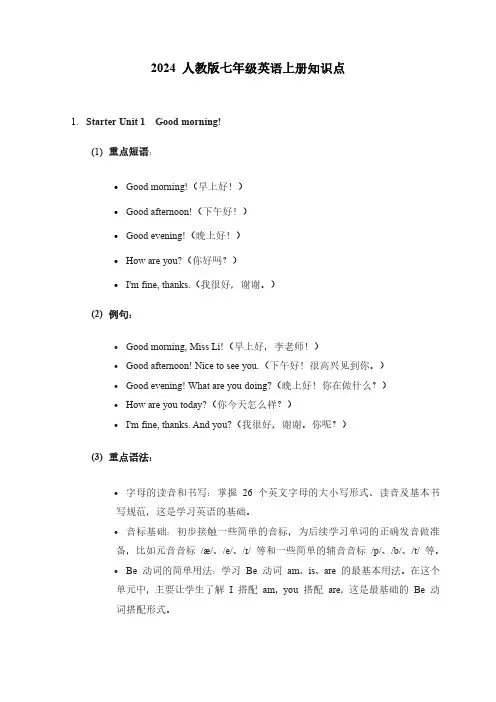
2024人教版七年级英语上册知识点1.Starter Unit1Good morning!(1)重点短语:∙Good morning!(早上好!)∙Good afternoon!(下午好!)∙Good evening!(晚上好!)∙How are you?(你好吗?)∙I'm fine,thanks.(我很好,谢谢。
)(2)例句:∙Good morning,Miss Li!(早上好,李老师!)∙Good afternoon!Nice to see you.(下午好!很高兴见到你。
)∙Good evening!What are you doing?(晚上好!你在做什么?)∙How are you today?(你今天怎么样?)∙I'm fine,thanks.And you?(我很好,谢谢。
你呢?)(3)重点语法:∙字母的读音和书写:掌握26个英文字母的大小写形式、读音及基本书写规范,这是学习英语的基础。
∙音标基础:初步接触一些简单的音标,为后续学习单词的正确发音做准备,比如元音音标/æ/、/e/、/ɪ/等和一些简单的辅音音标/p/、/b/、/t/等。
∙Be动词的简单用法:学习Be动词am、is、are的最基本用法。
在这个单元中,主要让学生了解I搭配am,you搭配are,这是最基础的Be动词搭配形式。
2.Starter Unit2What's this in English?:(1)重点单词:map(地图)cup(杯子)ruler(尺子)pen(钢笔)orange(橙子)jacket(夹克衫)key(钥匙)quilt(被子)what(什么)in(在……里)English(英语;英文)。
(2)重点短语:∙询问物品:What's this in English?(这个用英语怎么说?)、What's that inEnglish?(那个用英语怎么说?)∙回答方式:It's a/an...(它是一个……)。
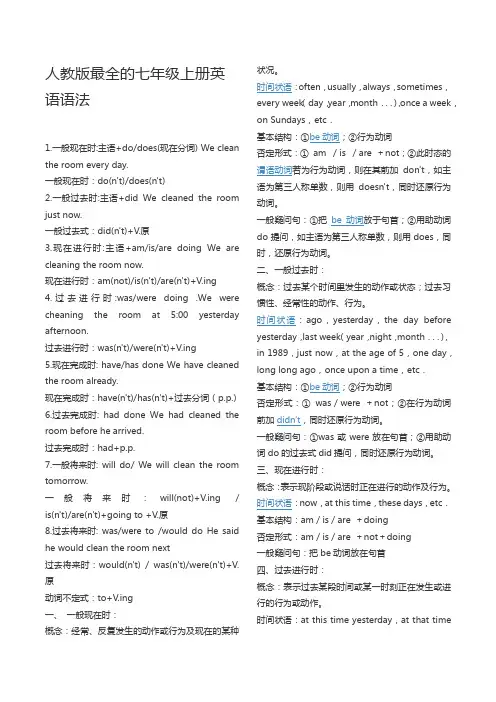
人教版最全的七年级上册英语语法1.一般现在时:主语+do/does(现在分词) We clean the room every day.一般现在时:do(n't)/does(n't)2.一般过去时:主语+did We cleaned the room just now.一般过去式:did(n't)+V.原3.现在进行时:主语+am/is/are doing We are cleaning the room now.现在进行时:am(not)/is(n't)/are(n't)+V.ing4.过去进行时:was/were doing .We were cheaning the room at 5:00 yesterday afternoon.过去进行时:was(n't)/were(n't)+V.ing5.现在完成时: have/has done We have cleaned the room already.现在完成时:have(n't)/has(n't)+过去分词(p.p.)6.过去完成时: had done We had cleaned the room before he arrived.过去完成时:had+p.p.7.一般将来时: will do/ We will clean the room tomorrow.一般将来时:will(not)+V.ing / is(n't)/are(n't)+going to +V.原8.过去将来时: was/were to /would do He said he would clean the room next过去将来时:would(n't) / was(n't)/were(n't)+V.原动词不定式:to+V.ing一、一般现在时:概念:经常、反复发生的动作或行为及现在的某种状况。
最新英语人教版七年级上册全册重点句型语法1. 主语 + be动词 + 宾语- 例句:I am a student.- 翻译:我是一个学生。
2. 主语 + be动词 + 形容词- 例句:She is tall.- 翻译:她个子高。
3. 主语 + be动词 + 名词- 例句:They are teachers.- 翻译:他们是老师。
4. 主语 + be动词 + 地点- 例句:We are at school.- 翻译:我们在学校。
5. 主语 + be动词 + 时间- 例句:He is in the classroom at 8 o'clock. - 翻译:他在八点钟在教室里。
6. 主语 + be动词 + 副词- 例句:I am here.- 翻译:我在这里。
7. 主语 + have + 名词- 例句:We have a book.- 翻译:我们有一本书。
8. 主语 + have + 动词过去分词- 例句:He has finished his homework.- 翻译:他已经完成了他的作业。
9. 主语 + have + to + 动词原形- 例句:They have to study for the test.- 翻译:他们必须为考试研究。
10. 主语 + can + 动词原形- 例句:She can swim.- 翻译:她会游泳。
11. 主语 + can + 动词原形 + 物品- 例句:We can ride bicycles.- 翻译:我们会骑自行车。
12. 主语 + can't + 动词原形- 例句:He can't speak Chinese.- 翻译:他不会说中文。
13. 主语 + like + 名词/动词/动词-ing- 例句:They like basketball.- 翻译:他们喜欢篮球。
14. 主语 + don't/doesn't + like + 名词/动词/动词-ing - 例句:She doesn't like swimming.- 翻译:她不喜欢游泳。
人教版七年级英语上册重点单词短语语法Starter unit 11. 短语归纳:good morning 早上好good afternoon 下午好good evening 晚上好name list 名单an English name 英文名字2. 必背典句:(1)Good morning! 早上好!(2)Good afternoon! 下午好!(3)Good evening 晚上好!3.英语中常见的问候语(1) Hello!“你好!”是比较随便、不分时间的一种问候语,通常用于打招呼、打电话。
表示惊讶或引起对方注意。
对方应答仍用Hello!(2) Hi!“你好!”的使用比hello!更随便,在年轻人中使用更为普遍。
(3) Nice to meet you!“很高兴见到你!”是两个初次见面、经介绍相识的人互相打招呼的用于。
回答时可以说Nice to meet you, too.或者Me, too.表示“见到你很高兴”(4) How do you do?“你好!”用于初次见面,是非正式的打招呼用语。
对方应答语应是“Howdo you do?”(5)How are you? 表示问候How are you? 意为“你好吗?”,为询问对方身体状况的问候语,应答语一般是“I’m fine.Thank you. / I’m very well. Thank you. / I’m OK.How are you? 的其他用法:习惯上回答完别人的问候后,常可反问对方的身体状况,此时可用How are you?也可用And you? “你呢?”4.大写字母的用法:(1) 在英语中,句子的第一个单词的第一个字母都应大写。
Sit down, please. 请坐。
(2)字母I作人称代词时,意为“我”,在句中任何位置都必须大写。
日常用语“OK”在句中任何位置都大写。
I’m a student. 我是一名学生。
Is everything OK? 一切都好吗?(3)人名、地名、国名、某国人或某种语言等专有名词的第一个字母都必须大写。
七年级上册语法总结一、词类二、名词1.名词:表示人或事物的名称1)总的来说,名词分为专有名词和普通名词两类。
专有名词时个别的人、事物、地点等专有的名称,如:Gina, China 等专有名词,专有名词第一个字母要大写。
2)名词按其所表示事物的性质分为可数名词和不可数名词。
可数名词(Countable Nouns)有复数形式,如:an apple, two apples。
不可数名词(Uncountable Nouns)一般没有复数形式,如:broccoli。
3)可数名词有单数(Singular Form)和复数(Plural Form)两种形式,以下介绍可数名词复数形式变化规则:*本册出现的不可数名词有:broccoli*既可数又不可数名词有:ice cream,salad,chicken2.名词所有格表示所属关系的一种格式1)-’s 所有格大多数表示有生命的名词的所有格名词,加-’s表示为各自所有的各个名词后都要变化,分别加-’sTom’s and Lucy’s books2)无生命的名词的所有格,一般由“名词+of+名词”构成Eg:a map of China 一副中国地图the capital of America 美国的首都*双重所有格由“名词+of+-’s”或“名词+of+名词性物主代词”构成Eg:a friend of my mother’s一个我妈妈的朋友a friend of theirs/his/hers/ours三、代词1.含义:代词是代替名词以及起名词作用的短语、不定式、V-ing 形式、从句或整个句子的词。
2.代词的分类(本书涉及三类代词):1).指示代词表示“这个”、“那个”、“这些”、“那些”等指示概念的代词单数复数用法例句this these 一般用来指时间或空间上较近的事物Is this your pencil?These are my pens.that those 一般用来指时间后空间上较远的事物Is that you grandfather?Those are his brothers.2)人称代词代指人或事物,在句中作主语或宾语,所以有主格和宾格形式人称单数复数主格宾格主格宾格第一人称I me we us第二人称you you you you第三人称he himthey themshe herit it3)物主代词表示所有关系的单词,是人称代词的属格形式。
人教版七年级英语语法点一、名词。
1. 可数名词与不可数名词。
- 可数名词有单复数形式。
复数形式的构成规则如下:- 一般情况加 -s,如book - books,pen - pens。
- 以s,x,ch,sh结尾的加 -es,如bus - buses,box - boxes,watch - watches,brush - brushes。
- 以辅音字母+y结尾的,变y为i再加 -es,如baby - babies。
- 以o结尾的,有生命的加 -es(如tomato - tomatoes,potato - potatoes),无生命的加 -s(如photo - photos,piano - pianos)。
- 以f或fe结尾的,变f或fe为v再加 -es,如knife - knives,leaf - leaves。
- 不可数名词没有复数形式,如water,milk,bread等。
表示数量时,要用“数词+量词+of+不可数名词”,如a glass of water,two cups of tea。
2. 名词所有格。
- 有生命的名词所有格:- 一般在名词后加's,如Tom's book。
- 以s结尾的复数名词,只加',如the students' classroom。
- 表示两者或多者共有时,只在最后一个名词后加's;表示各自拥有时,每个名词后都要加's。
例如:Tom and Jerry's room(他们共有的房间);Tom's and Jerry's rooms(他们各自的房间)。
- 无生命的名词所有格常用“of+名词”结构,如the window of the room。
二、代词。
1. 人称代词。
- 主格:I,you,he,she,it,we,you,they,在句中作主语。
例如:I am a student. He likes reading.- 宾格:me,you,him,her,it,us,you,them,在句中作宾语。
人教版七年级英语(上册)各单元语法梳理Unit 1:My name's Gina.嘿,大家好。
第一单元我们学习了部分人称代词主格和形容词性物主代词。
具体内容,请看下图趣解语法January 2021✍人称代词主格在句中作主语,是整个句子的龙头老大。
注意点:但值得注意的是:I 作主语时,be 动词用am;she/he/it 作主语时,be 动词用 is。
英语人称代词用法口诀:人称代词主宾格,作用不同莫用错。
主格动词前做主,动词介词后宾格。
You和it主宾同,其他主宾须分清。
人称代词并列现,尊重他人礼当先。
单数人称二三一,复数人称一二三。
若把错误责任担,第一人称我靠前。
✍形容词性物主代词具有形容词的特性,常放在名词前面作定语,表明该名词所表示的人或物是'谁的'所以我不能单独使用,其后必须跟名词。
比如:my name; your friend……英语物主代词用法口诀:物主代词分两种,形容词性名词性。
形容词性能力差,自己不能来当家。
句子当中作定语,身后定把名词加。
物主代词名词性,相当名词可单用。
句中充当主宾表,身后没有名词影。
两种代词形不同,添个 s 形变名。
his,its不用变,my变mine要记清。
话不多说,我们给大家来一些例证吧!✍经典例句1人称代词主格1. I am a girl. 我是一个女孩。
2. He/She is my friend. 他/她是我的朋友。
3. You are very nice. 你非常好。
4. It is a bed. 它是一张床。
2形容词性物主代词5. My name is Mary. 我的名字叫玛丽。
6. Your room is so tidy. 你的房间很整洁。
7. This is his/her pen. 这是他/她的钢笔。
8. That is my dog. Its name is Susan.那是我的狗。
它的名字叫苏珊。
9.He's a student. His mother is a teacher.他是一名学生。